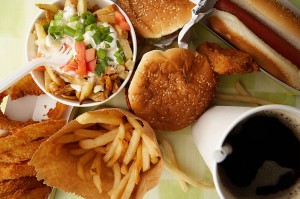This post may contain affiliate links.
This is a post I wrote for a nutrition policy class at school. We were asked to discuss if it was more important to address the issue of food deserts or food swamps. I personally think the problem goes way beyond food access, and lies primarily in our cultural prioritization of taste, cost, and convenience over health. Read on, friends!
While qualifying an area as a “food desert” may be misleading (see Esther’s post about our very own UNC campus being a “certified” food desert), I do believe there is a significant amount of food insecurity in our country that must be addressed in ways beyond simply providing emergency food assistance. I had first-hand experience witnessing the astonishing level of food insecurity that exists in the Triangle area this summer while working at the InterFaith Food Shuttle. The IFFS is doing a great job trying to make sustainable changes to food access in the greater Raleigh area by addressing food production and healthy food availability by teaching low-income communities how to produce and prepare healthier food. Programs like this are a great step towards reducing disparities in healthy food access and are making a difference in many people’s lives in our region.
However, for all the positive changes happening from programs like those provided by the IFFS, I think the problem of nutrition and obesity in America goes well beyond whether food access and whether or not a person lives in a food desert or food swamp. Frankly, I think the major problem is the type of food available to and preferred by most people in this country and the price people are willing (or able) to pay for what they eat. In other words, it’s not that healthier food isn’t available – it’s that most people just don’t care about purchasing it.
Taste and cost are the primary drivers behind food purchasing in the United States, and Americans spend the least amount of disposable income on food compared to any other country. As reported by professor Mark Perry, “the 5.5% of disposable income that Americans spend on food at home is less than half the amount of income spent by Germans (11.4%), the French (13.6%), the Italians (14.4%), and less than one-third the amount of income spent by consumers in South Africa (20.1%), Mexico (24.1%), and Turkey (24.5%).” Americans also only spend about 30 minutes per day preparing foods compared to an average of 52 minutes per day around the world, demonstrating our emphasis on minimal time investment in our food and reliance on convenience.
And food in America is cheap and easy to find, even in food “deserts.” The shelves of most grocery stores are lined with low cost, easy-to-prepare junk food high in calories and low in micronutrients. Fast food restaurants provide dollar menu cheeseburgers and fries cooked in cheap vegetable oil, and these foods are ubiquitous; there are now five fast-food restaurants for every supermarket in the U.S. Soda and other corn-sweetened beverages are far cheaper compared to most other beverages, and Americans have the highest per-capita soft drink consumption in the world, drinking about 760 8-ounce servings per year. Whether looking at low-income neighborhoods or high income developments, it’s clear that Americans have plenty of access to affordable, easily prepared food and beverages
But unfortunately, cheap and convenient food comes with an unforeseen cost; our nation’s health.
We all know the statistics on obesity: more than one-third of U.S. adults are obese, and obesity-related conditions include heart disease, stroke, type 2 diabetes and certain types of cancer, some of the leading causes of preventable death. And for all the public health efforts and “Let’s Move” campaigns initiated, the proportion of Americans who are severely obese continues to rise at staggering rates. So why is this happening? In my opinion, it’s because for all Americans know about nutrition and healthy food, they’re still valuing taste, price, and convenience over their health.
The government, through agricultural policy, is making choosing junk food even easier. The US PIRG reports that taxpayer agricultural subsidies are increasingly going towards junk food ingredients, mainly commodity crops such as corn and soybeans. These crops are not eaten as-is, but rather are manufactured into ingredients such as high fructose corn syrup and vegetable oils that add cheap sweetness and unhealthy fat to the inexpensive processed foods that make up the bulk of grocery store products. If taxpayers were given this subsidy money directly to buy food, they’d be given $7.36 to spend on junk food and 11 cents to buy fresh produce – enough for 19 twinkies and less than a quarter of an apple.
This government spending on agricultural commodities encourages Americans to buy the less expensive processed junk food over the more expensive, but healthier, fresh produce. These commodities also support the cheap meat that is mass produced by confined animal feeding operations (CAFOs), which drastically reduce the price of meat but simultaneously reduce the nutritional value of these meat products. Overall, our food policies largely support cheap, poor quality food that provides sub-par nutrition and encourages overeating even among those who have little money to spend on their food.
So, where should our resources be going to combat the problem? Should we be working towards addressing food deserts, food swamps, or both?
I actually think this question misses the point. The fact is, even in low income areas, people have plenty of access to “food”, but the type of food available and the demand for healthier options is the biggest issue. A recent UNC study found that living near a supermarket had little impact on whether people ate healthy food, but living close to fast-food outlets did. In other words, increasing the availability of healthy food does not generally lead to healthier eating. “It’s simplistic thinking that if you put fruits and vegetables there, they’ll buy it,” said lead author Barry Popkin. “You have to encourage it, you need advertising, you need support.” In order to change eating habits, consumers have to demand healthy food and be willing to pay extra for it.
So how do we change demand for healthier food? Is it the role of the government to tax junk food and soda, stop subsidizing commodity crops, and limit choices in SNAP food purchases? And where does personal responsibility come into play? Sure, the higher cost of healthy food can be prohibitive to lower income families, and I don’t blame them for choosing the cheapest food available. But maybe if as a nation we began prioritizing our families’ food budget over big-screen TVs and McDonald’s happy meals and didn’t equate caring about food quality with snobbish “elitism”, then perhaps food culture in this country would reach a tipping point where eating healthily and supporting local, sustainable agriculture was seen as a normal part of life.
Yes, I think food deserts and food swamps are a major problem for many low-income families. But I also feel these food access disparities are a symptom of a much more insidious issue facing nutrition and health in our country; the prioritization of price, convenience, and taste over quality, nutrition, and environmental sustainability of our food. And until a major, game-changing shift in American food culture happens, I don’t really see any hope of solving the food desert or food swamp issue. Cynical? Maybe. Though I prefer the term realistic.
Do you agree that our cultural priorities about food are way off the mark? Or am I completely off base here? Let me know in the comments!




+ show Comments
- Hide Comments
add a comment